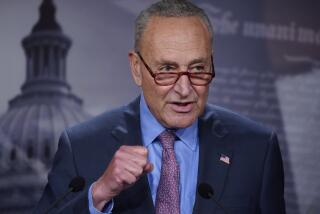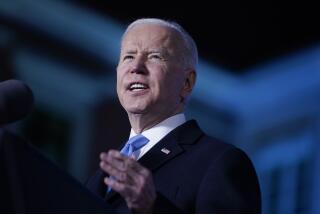Japan Eyes Stimulus Measures : Trade: $100-billion proposal is intended as a gift for Prime Minister Miyazawa to present to President Clinton next month.
TOKYO â A high-level task force of Japanâs ruling Liberal Democratic Party has proposed a $100-billion package of stimulative measures to help put Japanâs sluggish economy back on track and spur demand for American imports.
The proposal is intended as a gift for Prime Minister Kiichi Miyazawa to present to President Clinton when the two meet for the first time next month in Washington.
âWe have to stimulate the economy now,â said Hirohiko Okumura, chief economist at Nomura Research Institute. âWe had a $130-billion trade surplus last year; at this rate we will damage the world economy.â
The United States has been pressing Japan to improve its economy as one means of reducing its huge trade surplus. But while the measures are designed as a peace offering for Clinton, they may also be a matter of survival for Miyazawa.
The LDP faces parliamentary elections in the fall, and Miyazawa could be forced to step down if there is a poor showing at the polls--a possibility given the slumping Japanese economy and a series of recent political scandals.
At the heart of the ânew social infrastructureâ plan, as it has been dubbed, is a proposal to double the current $2,000 tax credit for interest paid on housing loans. Other new spending under consideration: $1.7 billion to buy 20 supercomputers (including some from the United States) for use in universities and research centers; $86 million for a fiber-optic system to serve as a model for high-tech highways (a plan similar to a Clinton proposal for the United States), and unspecified money to modernize facilities at national laboratories, university and hospitals.
The plan is drawing strong backing from a business community suffering from the double punch of weak demand and a rising yen.
âUp to now we have limited (stimulative) spending to such things as roads and bridges,â says Gaishi Hiraiwa, chairman of Keidanren, the big business association.
âIn the future we need to expand to such areas as âinformationâ investment,â he says.
If the package passes muster with tightfisted bureaucrats in the Finance Ministry, as most observers now believe it will, it could prove far more powerful than last yearâs widely touted $87-billion package.
âThings are beginning to turn around,â says Robert Feldman, economist at Salomon Bros. Asia Ltd. âThis will help a lot.â
Feldman argues that the impact of the package approved in December will become evident in the new fiscal year that begins April 1.
The new package, he suggests, would begin to take effect in September. Together, the two packages could boost Japanâs growth to 3% in fiscal 1993, more than double 1992 growth, says Feldman, one of the most bullish economists in Tokyo today.
Other economists are more guarded. The $100-million figure vastly overstates the actual amount of new money the government is pumping into the economy, says Geoffrey Barker, chief economist at the Tokyo office of Baring Securities.
Much of the money in the package will come from postal savings accounts, money that might otherwise have been deposited in banks and loaned out by the private sector, he says.
Nevertheless, Barker believes that the new package could have as much as $35 billion in direct government spending, twice the level of last yearâs package. The housing tax credit, he adds, will provide an important additional kick to the sluggish economy.
Economists say that while the proposed package would not actually shrink Japanâs bloated trade surplus, it would help prevent the surplus from continuing to grow by stimulating demand for imported products.
More to Read
Sign up for Essential California
The most important California stories and recommendations in your inbox every morning.
You may occasionally receive promotional content from the Los Angeles Times.










